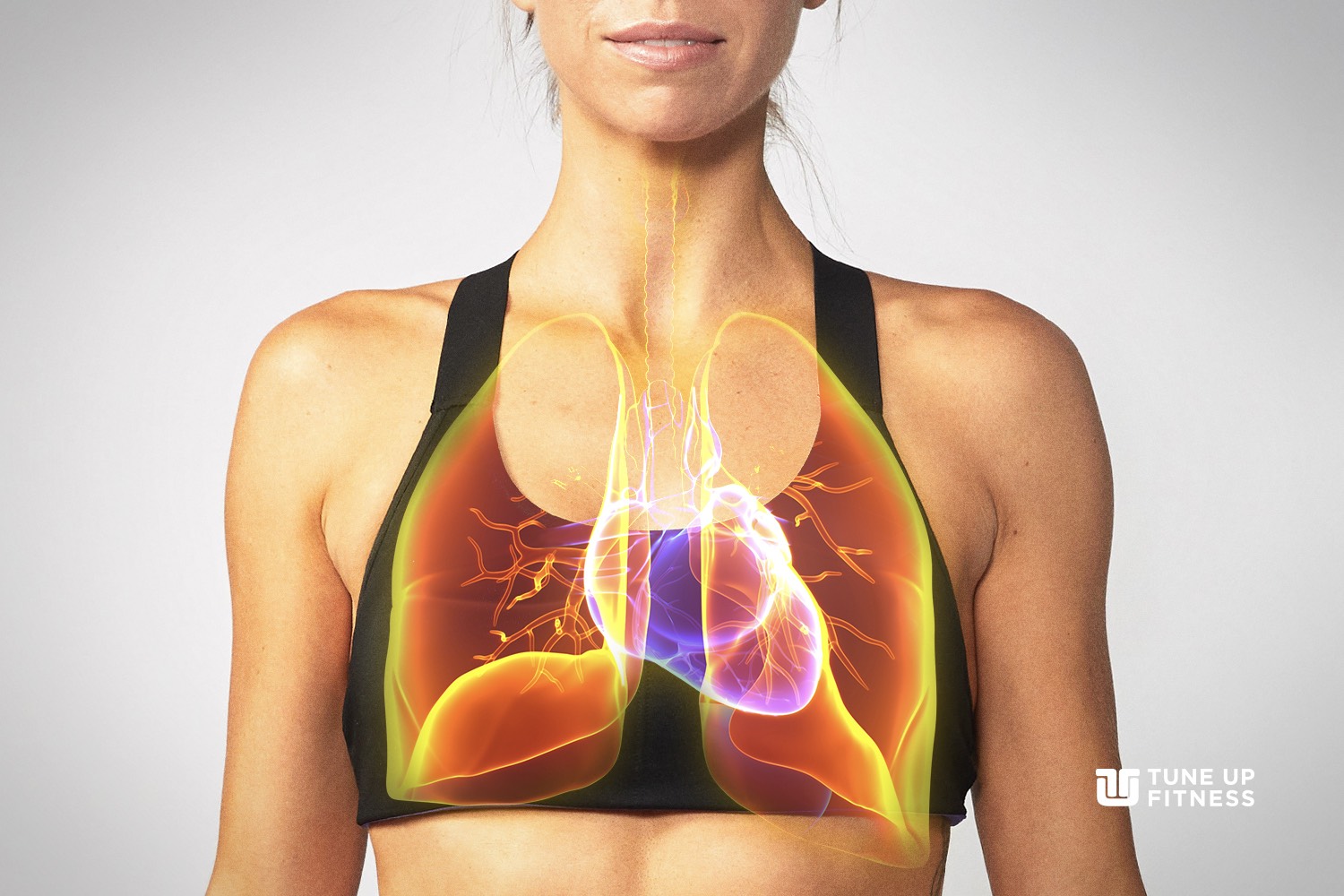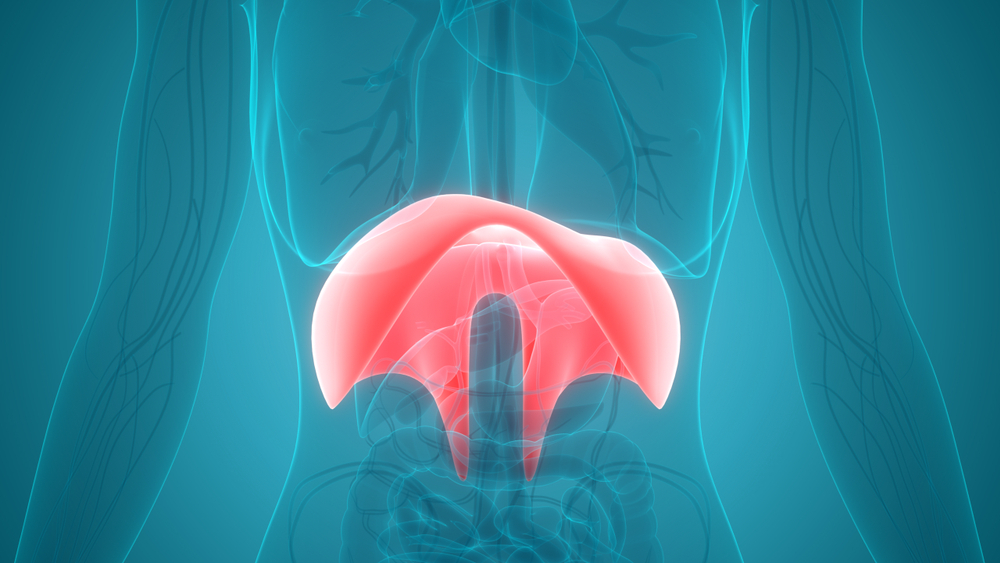
You’re driving home, and a car brandishing exactly the kind of bumper sticker that makes you seethe cuts right in front of you, almost causing an accident. You can feel your blood pressure rise and heart rate skyrocket as a burst of angry adrenaline hits your system.
Then, the moment is over, and although a stream of curses may offer temporary release, you want to bring yourself back to a place of genuine calm. How do you do it?
You might try telling your heart to slow down, but it doesn’t usually respond to orders. Fortunately, there is another way to invite the heart rate to slow: through your breath.
The Effects of Stress on Your Diaphragm Muscle, and Vice Versa

You’ve probably noticed this connection before—at times of stress or excitement, the breath tends to become shallow and quick as the heart rate also increases. Then, lying in Savasana or at other moments of deep relaxation, the breath is long and deep and the pulse slows down.
The breath is directly linked to both the sympathetic and parasympathetic nervous systems. This means that it reflects and creates our relative states of stress and relaxation. By learning to control the movement of the diaphragm, we can use this connection to our physical and emotional benefit.
Through the breath, it’s possible to decrease our fight, flight or freeze arousal—which is linked with a huge range of deleterious health effects. It’s also possible to increase our rest/digest/repair state–and the mental clarity and calm that accompany it.
But what is the diaphragm, exactly? It is the muscle whose function we depend on the very most, moment in and moment out. The diaphragm is snuggled under the lower half of the ribcage, attached to the inner surface of ribs 5-10 in the front and 10-12 in the back, as well as the lumbar vertebrae.
The diaphragm is often described as an umbrella or octopus shape. But it reminds me of a Lego-man’s removable plastic molded hair…

Its central tendon (where the part on a haircut would be) attaches to the lungs. Contracting the muscle fibers of the diaphragm pulls the central tendon down, which pulls the lungs down, which sucks air into the lungs. This is also known as inhaling.
Conversely, an exhale is the relaxation of the diaphragm’s fibers. This draws the muscle upward and pushes air out of the lungs. The heart sits on top of the diaphragm (like a jauntily angled hat). Then below are where the stomach, liver and lots of other organs reside.
Often, the times we most need to slow down our sympathetic nervous system (to “turn on our off switch” as Jill Miller says) are, by definition, moments of stress: Trying to navigate a toddler having a tantrum through a crowded store; arguing with a friend or partner; hearing critical feedback from a boss; listening to the news; getting ready for an exam; being in labor—there are countless times when being able to draw on our innate understanding of the breath/heartbeat/stress connection can help us slow down, stay calm, and make skillful decisions.

If possible, though, the best time to practice this connection and gain a real embodied understanding of it is when you are not under duress. So your mind-body can integrate the information and have it immediately accessible in times of need.
Because the diaphragm is not a muscle that we can see, the Coregeous® ball is an incredibly helpful tool to find it. This soft, spongy ball will increase your proprioception, or bodily awareness, of where this muscle is and how it works.
Mapping the Circumference of Your Diaphragm
Now that we know more about diaphragm physiology, to get to know your own respiratory diaphragm a little bit better, lie down on your back with the ball under your lower back ribs and thoracic vertebrae—approximately where your bra/bro strap hits.
- Inhale strongly and hold the top of the breath, keeping your diaphragm contracted for a moment. Notice the feeling of this muscle contracted against the Coregeous® ball.
Now exhale slowly, noticing the muscle relax and soften around the ball. - After a few repetitions on your back, turn over and place the ball in the archway under your front ribs. Repeat the same exercises, this time feeling the front of your diaphragm contract and press against the ball as you inhale, and relax and sink around the ball as you exhale.
- To complete your mapping of the diaphragm, do the same sequence on your right and left sides, with the Coregeous® ball pressed under your lower side ribs and external obliques.
Now that you have felt the circumference of the diaphragm in your body, you can attune yourself to the movement of this muscle as you mobilize the breath to down-regulate your heartbeat. A great way to do this is the simple practice of extended exhale.
Extended Exhale Practice
In a quiet moment, lie on the on your back, or sit in a supported seat, inhaling and exhaling through your nose with complete abdominal-thoracic (full torso) breaths.
- Count the length of your inhale and match it with the length of your exhale.
- Then increase the length of your exhale by 1-4 counts, for instance inhaling for a count of four, and exhaling for a count of six.
- In this quiet space, bring your attention to your heartbeat, either through feeling your pulse or interocepting (sensing within) the heart’s rhythm.
- See if you notice the way your heartbeat slows slightly with each extended exhale.
As good as it feels to practice the extended exhale breath in a quiet place, what makes it so powerful is that it can be practiced anytime, anywhere. Especially in those moments of stress when you need it most.
The Elastic Heart Breath Practice
Finally, let’s put this all together with a breath practice with Jill Miller called The Elastic Heart Breath.
When you attune to the movements of the diaphragm at a time of sympathetic nervous system arousal and invite it to slow down, your parasympathetic nervous system can take the wheel. Your stress response is given permission to chill out, and the flood of adrenaline and cortisol that accompany it slows down. Your prefrontal cortex, where thoughtful decisions are made, gets to take over for your lizard brain.
By deepening our felt awareness of the connection between the breath and the heart, we give ourselves a tool for managing stress in our daily lives and improving our long-term physical, mental, and emotional health.
Related Article: Respond Versus React: Restorative Practices for the Power Hungry
Learn more about our Therapy Ball Products and Programs
Interested in video and blog content targeted to your interests?












Once I learned how to perceive the diaphragm and watch the breath , my life changed. It is the best tool for inviting calmness in. The corgeous ball has enhanced my breathing practices tremendously. Ty
Every diagram of the Diaphragm that I’ve seen hasn’t really addressed the BACK of the body. And I’m looking at this one/ reading this blog thinking– there are more attachments to the posterior than the anterior… and why am I always thinking of the anterior/ lateral when it comes to breath!? Looking forward to getting a Coregeous ball and propriocepting breathing into the back of my body.
This is such a simple learning moment for me: every diagram of the Diaphragm that I’ve seen hasn’t really addressed the BACK of the body. And I’m looking at this one/ reading this blog thinking– there are more attachments to the posterior than the anterior… and why am I always thinking of the anterior/ lateral when it comes to breath!? Looking forward to getting a Coregeous ball and propriocepting breathing into the back of my body.
I have been exploring the difference between a down regulating breath and an up-regulating breath I will definitely be working more with the down regulating breath and share this with my students. The heart and breath connection is truly amazing. Thank you for these resources and videos.
Fascinating article on the link between the heart and the lungs and the means we have at our disposal to defuse the alarm system!
just wow, such an insightful article and videos, and the traffic examples at the beginning is spot on ha! Thanks for such a great share
As i read this, i had an idea to add: as you lay over the corgeous ball, find your pulse by putting your fingertips at your carotid artery, and use your own heart as a metronome for counting your breath. I haven’t tried it yet, but seems like a great way to connect heart and breath. Thanks for the inspiration.
If the heart sits on top of the diaphragm and the diaphragm is the primary breathing muscle, it is the proximate location that makes the breathing pace quickly impact the hearts pace? As it is possible to have a racing heart (like before having to make a public presentation) and have slow controlled breathing, what allows the breathing and heart rate to also be out of sync?
Je vois la différence dans mon humeur et ma digestion lorsque je prend le temps de bien respirer. Les premières fois que j’ai massé mon diaphragme, j’ai beaucoup d’émotion qui sont sorties. Je vois la différence en grosse période de stress.
Wonderful reminder and techniques for connecting with the breath in a conscious way. This conscious connection allows the breath to be more than “just keeping us alive” but to be use as a tool to improve our lives.
Súpero completo este artículo. No sólo la explicación minuciosa del funcionamiento del diafragma, su relación con el temor y la posibilidad que tenemos de aprender a desactivar nuestro sistema de alarma frente al peligro. Poder reconocer cuando el estrés se hace presente en nuestras vidas y tomar la decisión de no querer convivir con el.
Siento en este momento un gran deseo de probar los ejercicios propuestos en los videos, voy a conseguir una pelota!!!.
gracias
I’ve used breath to create calm, but haven’t connected it this directly to my diaphragm. This will help to be more embodied in my practice next time I use it.
When stressful situation I have been only thinking about stiffness of neck shoulder, and want to get rest,but it is not only one part of physical body stress but related with breath and diaphragm tension.
Some time I had diaphragm massage with boll rolling without know relationship between diaphragm and breath , that why I felt great relaxation.
The diaphragm is an overlooked and under appreciated part of the body, and the Coregeous ball is an effective way to elicit feedback from this (primary) breathing muscle. Getting in tune with this muscle will improve how your breathing process feels and functions.
I love my Coregeous ball. All human beings should get this essential accessory to get a better quality of life. Breath is the base and people do not know how to use their most important muscle that is the diaphragm.
I’ve always had an appreciation for body-breath and heart-breath connection, mainly because of my experience with it. It has helped me so many times in stressful situations. I love how this article provides an explanation from a scientific perspective, that’s quite empowering for me as a teacher. Thank you for sharing this!
The elastic heart breath practice, for sure I’ll include it in my daily routine. It’s fantastic not only you become aware of your diaphragma muscles but also you can control the rhythm of your breath and relax, plus as a bonus you improve your posture. That’s amazing. Thanks.
Even though I have been practicing yoga for a long time, I have not realized the importance of breathing. As I concentrate on improving my poses, I will also focus on breathing as you mentioned in your article. Thank you.
The Coregeous®️ball is helping me better connect with my abdominal breathing to stimulate my parasympathetic nervous system. I needed to map my diaphragm to expand my belly more. Great video!
Can’t wait to use the Coregeous® ball to map my diaphragm and try out the Elastic Heart Breath practice, thank you! I love incorporating new things into my practice, and have no yet used the Coregeous® ball enough. I love the downregulating that extended exhales provide, and playing with upregulating and downregulating during practice or in daily life to really experience how breath has such an integral part in our state of mind, body, and emotions. Observing how and when these changes occur naturally has been so beneficial.
As a yoga teacher, mother, and boss I see when individuals become agitated or stressed. I have used the practice of breathing with your diaphragm and abdominal muscles to “calm “ a person . These examples given in this blog will be added to my tool box of life.
The more I learn about the diaphragm, the more intrigued I become. Great sequence to reconnect and feel your diaphragm working as you breathe. I also like that diaphragmatic work is introduced originally because of increased heart rate and how while you cannot consciously tell your heart rate to slow down in the moment, if you are able to look at your system in a holistic way (aka maybe bringing some attention to what you’re diaphragm is doing in that moment), there are conscious deliberate steps you can take to affect the body, just maybe not the first instinct you think of. Spending the time to get to know our bodies builds self intimacy and self intimacy evolves our practices to benefit and remedy our individual needs so we can better understand and heal the body when it sends us signals like increased heart rate or other seemingly worrisome symptoms.
Just took a break from tapping away at my computer to practice the Elastic Heart Breath. Deep and delicious. After just a few minutes, ‘m already more relaxed, sitting taller and breathing better.
The Coregeous® ball and the Elastic Heart Breath practice is excellent biofeedback!
this was an excellent article. it really reminds me to use my breath even in day to day challenging situations. knowing the anatomical connections of the organs helps me to understand why the diaphram can be affected by tightness in other parts of our body.
I was on the road driving and was cut off quite abruptly. Had to slam the brakes and steer to the next lane to miss the car that jetted in front of me. As a result my heart rate started racing and I wanted to scream in anger. Instead I tuned into my heart rate and breath. Within 10-15seconds I was over it and taking my time during my ride to work. Going to practice the videos, thank you.
It’s so important to learn these techniques for self regulation. Mapping is such a great way to understand what is going on and how it is affecting your body.
Thank you for this article.
Karla
Coregeous <- what a creative name! Just learned the correct pronounciation yesterday ?? love it! Anyways this article is amazing….I love the demo video of how to locate our diaphragm on all four sides (sometimes I forget I’m not just front and back side) as well as Jill’s elastic heart breath video — I am laying in bed with a sore back from oversleeping and I can imagine how good I would feel after doing the elastic heart breath! ? Thank you!